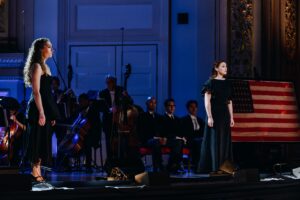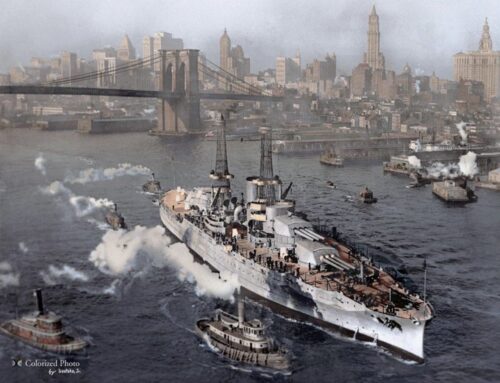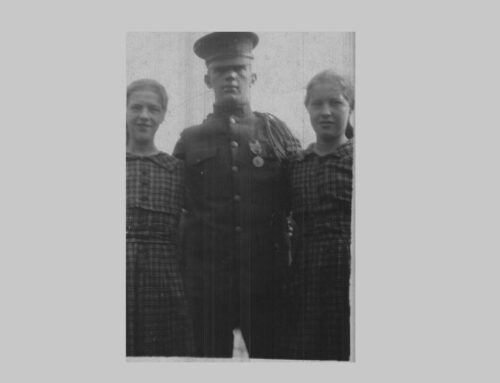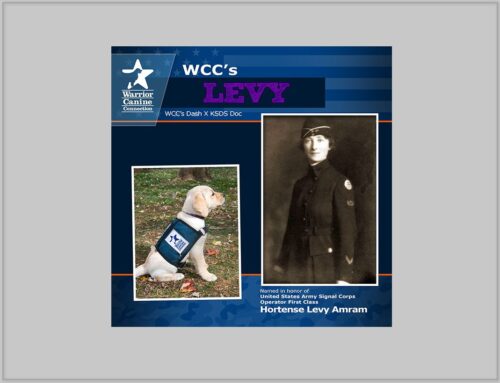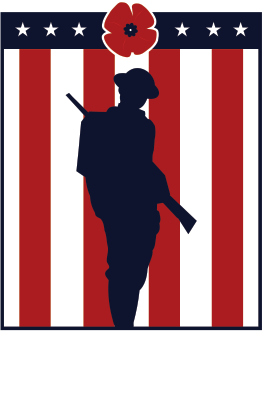American Heart In WWI: A Carnegie Hall Tribute brings America’s World War I story to life
Published: 27 October 2025
via American History Unbound
Caption_ Rare and iconic archival film and images are featured
Rare and iconic archival film and images are projected at Carnegie Hall during the production of American Heart In WWI: A Carnegie Hall Tribute. (Credit: Nina Westervelt)
Q&A with Historian John Monsky, Creator and Narrator of AMERICAN HEART IN WWI: A CARNEGIE HALL TRIBUTE
Premieres Veterans Day, November 11, on PBS and Streaming on PBS.org and the PBS app.
Powerful storytelling, breathtaking music, rare and iconic archival film and images, unforgettable characters, and meticulously researched history all come together in American Heart In WWI: A Carnegie Hall Tribute, a panoramic musical and visual account that brings America’s World War I story to life.
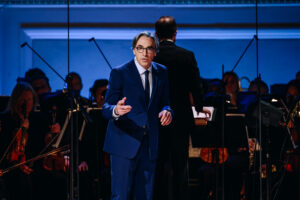
Creator and narrator of the show, historian John Monsky, with the 60-piece Orchestra of St. Luke’s. (Credit: Nina Westervelt)
Created, written, and narrated by historian John Monsky and directed for the stage by Tony Award winner Michael Mayer (Spring Awakening), this tribute to those who fought, and those they left behind, premieres Veterans Day, Tuesday, November 11, 2025, 8:00-10:00 p.m. ET (check local listings) on PBS, PBS.org and the PBS app.
Filmed at Carnegie Hall in April 2025 by the Academy Award-winning RadicalMedia, this living documentary features the 60-piece Orchestra of St. Luke’s and a stellar cast — Adam Chanler-Berat (Next to Normal), Nicholas Christopher (Hamilton, Chess), Micaela Diamond (Parade), Gracie McGraw (BABE) and Diego Andres Rodriguez (Sunset Boulevard), conducted by music supervisor and arranger Ian Weinberger (Hamilton, Chess).
Drawing on songs from the era by Irving Berlin, James Reese Europe, and George M. Cohan, among others, as well as historic film and photographs from the frontlines, American Heart in WWI explores the experiences of real-life figures whose courage and loss helped define the postwar generation.
Monsky uses F. Scott Fitzgerald’s The Great Gatsby—published 100 years ago—as a lens to examine how veterans like Jay Gatsby and Nick Carraway mirrored the disillusioned soldiers returning home from the Great War.
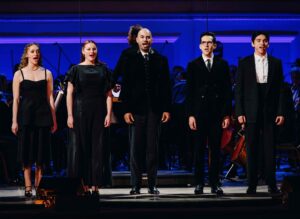
Left to right: Micaela Diamond, Gracie McGraw, Nicholas Christopher, Adam Chanler-Berat and Diego Andres Rodriguez. (Credit: Nina Westervelt)
Among the real-life heroes featured are:
– James Reese Europe, the trailblazing bandleader and Harlem Hellfighter who brought jazz to the world stage.
– Vera Brittain, a nurse, writer and later pacifist whose wartime sacrifice was a defining voice to a generation of women.
– Charles Whittlesey, a shy New York lawyer who led the “Lost Battalion” through the largest battle in American history — an action that earned him the Medal of Honor.
– Quentin Roosevelt, the youngest son of President Theodore Roosevelt, a fighter pilot who embodied the idealism and tragedy of youth in war.
– Flora Payne Whitney, debutant and future philanthropist, engaged to Quentin, and left devastated by his death in combat.
Q: This special premieres on Veterans Day. Why was it important for you to connect this program to that date?
Veterans Day has its roots in World War I. Originally called Armistice Day, it marked the moment the guns fell silent on November 11, 1918—the end of WWI, what people then called “the war to end all wars.” Over time, it evolved into a day to honor all American veterans, but its origin story is deeply tied to the sacrifices and idealism of that first generation of soldiers. American Heart in WWI tells the story of that generation and reminds us why this day of remembrance exists in the first place.
Q: How does AMERICAN HEART IN WWI: A CARNEGIE HALL TRIBUTE bring that history to life for a modern audience?
We combine live music, archival film, rare photographs, historic flags and dramatic storytelling to create what we call a “living documentary” or “emotional history.” History isn’t just recited; it’s experienced through words, photojournalism, art, and music of the time.
Q: The production uses The Great Gatsby as a framework. Why F. Scott Fitzgerald?
Fitzgerald was a World War I veteran, and The Great Gatsby is really a war novel in disguise. Its disillusioned characters—Jay Gatsby and Nick Carraway—represent the lost generation shaped by the Great War. By using Fitzgerald’s story as a narrative thread, we connect audiences to the optimism before the war, the trauma of battle, and the search for meaning postwar.
Q: Tell us about some of the real-life figures featured in the program.
We highlight five extraordinary people. There’s James Reese Europe, the trailblazing Black composer and Harlem Hellfighter who changed American music forever. Vera Brittain, a nurse and writer whose wartime losses inspired her life’s work as a pacifist. Charles Whittlesey, the shy New York lawyer who led the “Lost Battalion” in one of the war’s bloodiest battles. Quentin Roosevelt, the youngest son of President Theodore Roosevelt, whose death symbolizes the war’s tragic cost and his fiancée, Flora Payne Whitney, who reflects the enduring pain of loss. Through them all, we feel the heartbeat of a young America learning what service and sacrifice truly mean.
Q: The performance was filmed at Carnegie Hall. What does that setting bring to the story?
Carnegie Hall is sacred ground for American music. Many of the composers whose songs we perform—Irving Berlin, George M. Cohan—had their work played there a century ago. Presenting this story in that same space bridges the past and present. It’s both a concert and an act of remembrance. And on May 2, 1912 at 8:15 p.m., a racially mixed audience filled the sold-out concert hall to celebrate James Reese Europe’s 125-piece Clef Club orchestra, which captivated the audience. A special moment occurred during the taping of the show, where the descendants of James Reese Europe stepped foot on the very stage, 113 years later.
Q: What do you hope viewers will take away from watching on Veterans Day?
I hope they understand that Veterans Day isn’t just a holiday—it’s a promise. A promise to remember the men and women who put their lives on hold for something greater than themselves. When you learn about their courage, their humanity, their music—it deepens your appreciation for every veteran who has served since. This program is my way of saying thank you, and of passing history (and that gratitude) forward.
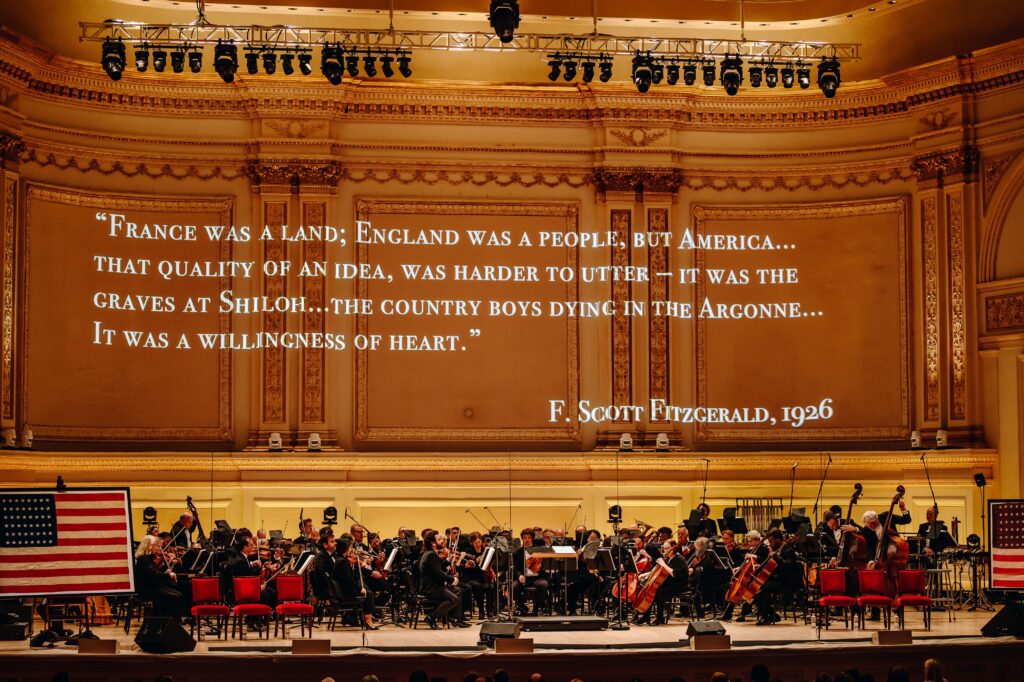
The production uses F. Scott Fitzgerald’s The Great Gatsby as a framework to guide the audience. (Credit: Nina Westervelt)
Q: You’re a historian, but your productions feel theatrical and emotional. How did that blend come about?
One summer, my wife and I decided to host a little neighborhood party for our kids, their friends, and their parents before the kids went off to camp. We picked Flag Day and I decided to say a few words about one of the flags in my collection. My, wife, who plays the piano, added the music. This became an annual gathering and I eventually added film, Broadway singers and storylines about the moment in history that a particular flag witnessed. Before we knew it, our apartment was overflowing. One year, I did a presentation about the Vietnam War and the head of the New York Historical, who had been invited to attend, asked me to perform it on their stage. Not long after, Clive Gillinson, the artistic director of Carnegie Hall called me and asked me to do the show at Carnegie Hall, as part of a Robert Caro-curated festival on the sixties. It was an unlikely road to Carnegie Hall and PBS and I am extremely fortunate to have these platforms to share the stories behind these historic flags and honor America’s veterans.
Q: Finally, why does World War I still matter today, more than a century later?
World War I shaped the world we live in—politically, socially, and culturally. It gave rise to the modern era, to new forms of music, art, and literature, and it changed our understanding of what service and citizenship mean. Veterans Day began with those soldiers, but its message endures: freedom and peace are never guaranteed; they must be remembered, protected, and honored.
American History Unbound is incredibly grateful to the organizations and institutions who are dedicated to keeping the legacies and stories alive.
To learn more about American History Unbound series, visit https://www.
External Web Site Notice: This page contains information directly presented from an external source. The terms and conditions of this page may not be the same as those of this website. Click here to read the full disclaimer notice for external web sites. Thank you.
